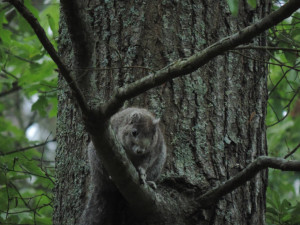When I started looking into opportunities to get involved with squirrel conservation, I expected to see many efforts that focus on the European Red Squirrel in the UK and Ireland- and my expectations were more than met. In fact, I had to do a little digging to find groups that even mentioned other squirrel species, but they are out there, and there are many, many ways to participate in squirrel conservation.
Starting with the most popular kid at squirrel school, you’ve got a number of options for helping European red squirrels (and this is only a tiny sample of the groups out there- I didn’t want to run out of space before I got to any other species…)- from the UK Forestry Commission’s Red Squirrel Conservation work to the Red Squirrel United Project, or the Red Squirrel Survival Trust, or Scottish Wildlife Trust’s Saving Scotland’s Red Squirrel program, or any of the other regional groups, you can donate time and/or money, you can report sightings, you can take part in monitoring surveys, and, for those of us on the far side of the pond who have suddenly realized how close the end of the year is, you can buy Allerdale Red Squirrel Group’s 2016 calendar.

The Delmarva fox squirrel population is growing thanks to conservation efforts. Photo courtesy of USFWS
I did manage to find a research project involving red squirrels in North America that was looking for public help, but the VT Center for Ecosystem Studies wants volunteers to help document bird nest and squirrel distribution to better understand the impact of red squirrels on nestling survival- it’s not about protecting red squirrels, but it is research about squirrels, and they do want help from everyone.
Looking at other squirrel species in North America, several programs have specifically targeted species living in forests across the continent- Oregon Fish & Wildlife has a “Living with Wildlife: Tree Squirrels” factsheet; Conservation Northwest is looking for donations and volunteers to help them monitor the western gray squirrel and the Pacific Biodiversity Institute needs volunteers to help deploy hair tubes as part of a population study for the same subspecies; Washington Fish & Wildlife provides plans for nest boxes that work for both Douglas and flying squirrels; the Humane Society Wildlife Land Trust has a sanctuary creation and monitoring program for wildlife including the southern flying squirrel; and, if you just want to ensure tree squirrels are regular visitors to your yard, there are squirrel feeder designs.
There are also a number of conservation efforts that focus on ground squirrels- Defenders of Wildlife has been working to protect the Mohave ground squirrel and the Ojai Valley Land Conservancy has been working to protect the California ground squirrel; Wild Earth Guardians has a prairie dog protection program, and they are looking for volunteers to help with office work and photography; both the Great Plains Restoration Council and Northern Rockies Conservation Cooperative include prairie dogs in their conservation work and you can make donations to their organizations; and the Utah Prairie Dog Habitat Credits Exchange and Safe Harbor Program encourages ranchers to maintain habitat for prairie dogs in return for financial benefits.
So there are lots of ways we can get involved with squirrel conservation, whether we want to directly participate in squirrel protection or contribute from a distance, whether we want to focus on squirrels leaping from tree to tree or on squirrels in underground burrows, and whether we want to work just with squirrel species or broaden our efforts to the entire ecosystem. And, if you think that perhaps efforts to support squirrel populations don’t really make a difference, check out the latest announcement about the Delmarva fox squirrel for some good news on the squirrel front.
